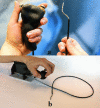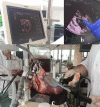First Expert Evaluation of a New Steerable Catheter in an Isolated Beating Heart
- PMID: 33210258
- PMCID: PMC7782459
- DOI: 10.1007/s13239-020-00499-3
First Expert Evaluation of a New Steerable Catheter in an Isolated Beating Heart
Abstract
Purpose: In previous studies we developed two mechanical prototypes of steerable catheters: the Sigma, which uses joysticks to actuate two steerable tip segments, and the Epsilon, which has a handle that is an enlarged version of the tip. In this study, we present a first performance evaluation of the prototypes in the cardiac environment. The evaluation was carried out by an expert user, an electrophysiologist with over 20 years of experience, to obtain insight in clinically relevant factors.
Methods: Two experiments were conducted. In the first experiment, the Sigma was used in a passive beating heart setup connected to pumps with a saline solution and camera visualization, and compared with the expert's past experience with conventional steerable catheters. In the second experiment, the Sigma was used in an active beating heart setup with blood perfusion through the coronary arteries and echo visualization, and compared with the Epsilon prototype. The prototype was evaluated through questionnaires on task performance, catheter usability, and workload. After each of the experiments, the catheter characteristics were evaluated via a survey and followed by an in-depth interview.
Results & conclusions: The expert user found the passive beating heart setup to more successful than the active beating heart setup for the purpose of this experiment, with insightful visualization while the heart was in beating condition. The steerability of the prototypes was experienced as useful and clinically relevant. Based on the questionnaires and interview we were able to identify future design improvements and developments for the steerable catheter prototypes.
Keywords: Beating heart; Catheter design; Evaluation; Expert opinion; Steerable catheter.
Figures












Similar articles
-
Steerable Catheters in Cardiology: Classifying Steerability and Assessing Future Challenges.IEEE Trans Biomed Eng. 2016 Apr;63(4):679-93. doi: 10.1109/TBME.2016.2525785. Epub 2016 Feb 4. IEEE Trans Biomed Eng. 2016. PMID: 26863645 Review.
-
Catheter steering in interventional cardiology: Mechanical analysis and novel solution.Proc Inst Mech Eng H. 2019 Dec;233(12):1207-1218. doi: 10.1177/0954411919877709. Epub 2019 Oct 3. Proc Inst Mech Eng H. 2019. PMID: 31580205 Free PMC article.
-
The evaluation of steerable ultrasonic catheters for minimally invasive MRI-guided cardiac ablation.Magn Reson Med. 2014 Aug;72(2):591-8. doi: 10.1002/mrm.24945. Epub 2013 Sep 20. Magn Reson Med. 2014. PMID: 24114767
-
Lesion Size and Safety Comparison Between the Novel Flex Tip on the FlexAbility Ablation Catheter and the Solid Tips on the ThermoCool and ThermoCool SF Ablation Catheters.J Cardiovasc Electrophysiol. 2016 Jan;27(1):102-9. doi: 10.1111/jce.12835. Epub 2015 Nov 18. J Cardiovasc Electrophysiol. 2016. PMID: 26359632
-
Novel Uses of the SwiftNinja Steerable Microcatheter for Pediatric Cardiovascular Interventions.Pediatr Cardiol. 2025 Apr;46(4):921-929. doi: 10.1007/s00246-024-03516-7. Epub 2024 May 18. Pediatr Cardiol. 2025. PMID: 38761285 Free PMC article. Review.
Cited by
-
Characterization of Surgical Tools for Specific Endovascular Navigation.Cardiovasc Eng Technol. 2022 Oct;13(5):751-763. doi: 10.1007/s13239-022-00612-8. Epub 2022 Mar 2. Cardiovasc Eng Technol. 2022. PMID: 35237938
-
The evolution of technical prerequisites and local boundary conditions for optimization of mitral valve interventions-Emphasis on skills development and institutional risk performance.Front Cardiovasc Med. 2023 Jul 21;10:1101337. doi: 10.3389/fcvm.2023.1101337. eCollection 2023. Front Cardiovasc Med. 2023. PMID: 37547244 Free PMC article. Review.
References
-
- Ali A, et al. Steerable catheters in cardiology: classifying steerability and assessing future challenges. IEEE Trans. Biomed. Eng. 2016;63:679–693. - PubMed
Publication types
MeSH terms
LinkOut - more resources
Full Text Sources
Miscellaneous

